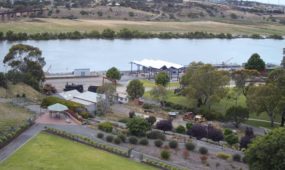Cellar to showcase best of Barossa to the world
Uncategorized
AUSTRALIA’S premier wine region is looking to strengthen its global position by building a world-class cellar and function centre to store and showcase more than 2000 dozen bottles of the region’s wines.

Sign up to receive notifications about new stories in this category.
Thank you for subscribing to story notifications.
The Barossa Cellar project in South Australia aims to showcase many of the region’s best wines at their optimal drinking age to wine industry representatives, buyers and journalists.
While the need for such a facility has been discussed by winemakers in the Barossa Valley for several years, the project has taken significant steps forward in recent weeks and could open as soon as March 2018.
The $4.5 million project is being driven by the Barons of Barossa, a group of influential wine industry personalities from the region, and has recently secured a major tenant and council building approval to develop the 2.8 hectare (7 acre) site between the townships of Tanunda and Angaston in South Australia.
The Barons bought the land last year and will contribute $1 million to the project. A fundraising campaign to raise the remaining $3.5 million will be launched next month.
The Barossa Valley, about 70km north of the South Australian capital Adelaide, is home to many of Australia’s most famous wine brands including Yalumba, Penfolds, Wolf Blass and Jacob’s Creek.
Barossa Cellar Committee Chairman and Barossa Baron James Wark said the lease agreement signed last month with the Barossa Grape and Wine Association (BGWA) would bring the building to life and ensure the wine in the cellar would be used to maximum effect. As part of the deal, the BGWA will be given an annual promotional allocation of wine from the cellar.
Wark said having the collection all in one place for the first time – rather than in various cellars around the region – would allow for consistent cellaring in “pristine” conditions and improved cataloguing and access to the wine.
“We decided that while we wanted this wine cellar, we also wanted it to be a living place and not just something that was a dormant cellar,” he said.
“What I think we’re going to be able to do is to really promote the Barossa in a fantastic new way through this whole association with the BGWA in there and giving them access to these fantastic wines, which can be used responsibly to promote the whole region.
“They also have a number of guests come to the Barossa Valley such as wine writers, wine buyers and people wanting to undertake master classes for educational purposes and they have previously been limited in what they can do at their small office in Tanunda.”
According to the Organisation of Vine and Wine, Australia was the world’s fifth largest wine-producing nation in 2016 behind Italy, France, Spain and the United States.
South Australia is consistently responsible for about 50 per cent of Australia’s total annual production and about 75 per cent of premium wine.
Australian wine is experiencing a resurgence on international markets such as North America and China, particularly in premium categories
The Barons of Barossa formed in 1975 and built its collection from annual wine donations from local companies to store and use their best wines at functions for people who can benefit the region.
The collection of predominantly red wines has reached more than 2000 dozen and includes wines more than 20 years old from iconic Barossa wineries such as Henschke, Penfolds, Rockford, Yalumba, Greenock Creek, Peter Lehmann and Grant Burge.
“It’s the most significant Barossa wine collection of historic wines that’s available,” Wark said.
“Really there’s only three such facilities globally and they are all in Europe.
“I’m always surprised by the stunning wines they bring out and the things that are unique about them is they do go back for many years so if you were holding a masterclass with an influential group of people we can give an enormous history of wines from different vintages and from different regions within the Barossa.”
The block of land slopes down to the west. The building will be built into the side of the hill with the cellar section effectively underground and the offices and “Grand Hall” positioned towards the front of the building.
The building will also feature polished concrete floors using crushed stone sourced from different sub-regions within the Barossa to reflect the area’s various terroir.
“It’s going to be very environmentally constructed and it’s going to have some stunning views looking out to the west across the Barossa Valley and across the vineyards,” Wark said.
“It’s not going to just be a stone building with no personality, it’s going to be done with a great deal of sympathy to where it sits and with taste.”
The fundraising campaign will launch in April and will involve a number of levels of support starting at $500 for the naming rights to a stone used in the building’s entrance or $1000 to buy one of the 1800 vines in the surrounding vineyard in perpetuity.
Higher level contributions will be part of a “key” system where donors will be invited to attend functions such as the inaugural opening of the Barossa Cellar and exclusive VIP holiday packages to the region as well as red carpet tastings and visitor experiences at various local wineries.
These packages will start at $10,000 for a “Barossa Key” through to $250,000 for the ultimate “Diamond Key” for eight people.
The cellar will be built by Barossa Valley-based construction and engineering company Ahrens Group.
Managing Director Stefan Ahrens, who is also a Baron of Barossa and on the Barossa Cellar Committee, has agreed to carry out the build at cost price.
“As you can imagine, the margins on a $4.5 million project are quite significant so that is a very generous contribution,” Wark said.
“We’ve got council approval, we’ve got a tenant and now we’re going to the next step of getting the funding organised.
“We’ve done a lot of preparation for it, we’re gathering names, we’re gathering a lot of information and in April it’ll be seen and people will notice it.”
Wark said the Barons of Barossa would have a small presence in the building with an office and small meeting room.
“It’s not a flag waving exercise for the Barons, it’s something we think will be a great benefit to the whole Barossa grape growing, winemaking and broader community,” he said.
Jump to next article



